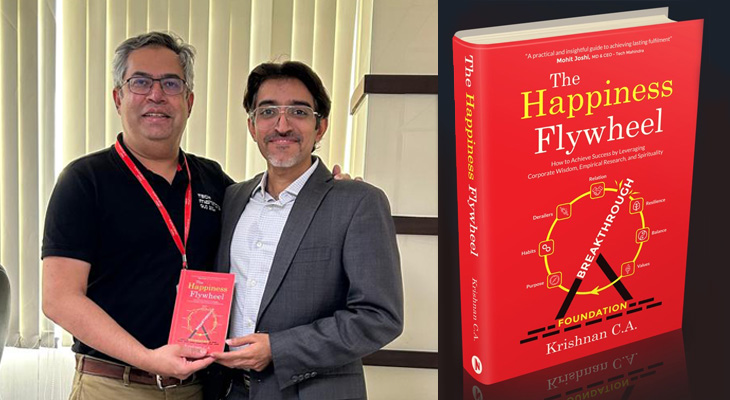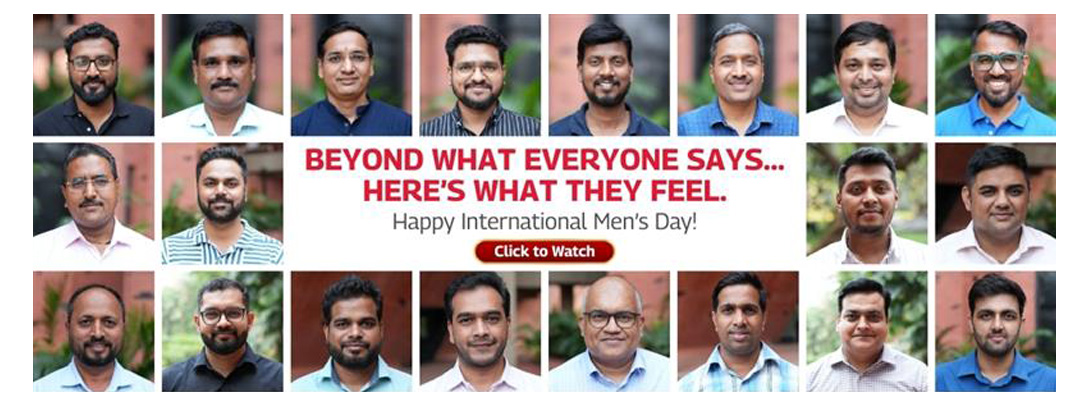Meet Krishnan CA, SVP of the Strategic Solutions and Transformation Unit - Large Deals at TechM heading the Deal Director and Cluster Head function globally. .
Krishnan has recently released a book The Happiness Flywheel: How to Achieve Success by Leveraging Corporate Wisdom, Empirical Research, and Spirituality, that offers practical ideas on how professionals can find balance, happiness, and success in life and work.
Tech Mahindra’s Rapid Recap team caught up with him and chatted with him on happiness, spirtuality, eureka moments and more.
Excerpts from the interview.
What inspired you to write the book?
This book has been a labour of love, a journey that began during the pandemic, with most of it written in those reflective times. Happiness as a subject has always fascinated me. However, the challenge is that everyone has an opinion on it, and many self-help books often lack depth, offering clichéd advice. On the other hand, some deeper books attempt to link happiness to a single concept, like a growth mindset or positivity, but they feel too narrow. Academic research, while insightful, is often too dense and difficult to consume, as seen in works like Martin Seligman’s or other. Spirituality offers profound wisdom but is often too complex for most people to adopt practically and relate to in the corporate setting.
The motivation to write this book was to simplify the subject of happiness while grounding it in empirical research and making spiritual insights relatable and accessible. My goal was to create a practical guide for young professionals that offers actionable steps to lead a happier and more fulfilled life.
How did you arrive at the three aspects of your book?
The three aspects of the book were inspired by a combination of my experiences:
Learning from leaders: My exposure to top leaders in my professional career allowed me to incorporate invaluable lessons from their perspectives and approaches to happiness
Empirical research: My reading of works by authors like Martin Seligman, Clayton Christensen, and Barbara Frederickson etc…provided a strong research foundation. For example, Christensen’s ideas on purpose and Frederickson’s work on Positive Psychology influenced the book’s framework. The Marshmallow experiment and findings in different context, was quite insightful.
Spiritual wisdom: Finally, my deep dive into the Bhagavad Gita, inspired the inclusion of spiritual insights. These learnings helped me zero in on actionable principles to help readers cultivate happiness in their lives.
What makes you the happiest?
I find happiness in moments of purpose, growth, and balance. Seeing others succeed, especially my team and knowing that I have made a positive impact on their journey gives me immense joy. Additionally, when I engage deeply in meaningful work or spend time with my family, I experience a deep sense of fulfillment and peace.

What’s one story or anecdote from the book that struck with you?
One powerful story I’ve recounted is from Professor Clayton Christensen’s book How You Measure Your Life, where he describes his Harvard reunion. Despite being some of the brightest minds, many of his batchmates faced significant personal challenges due to poor decisions. He highlights the importance of living by your values, emphasizing that it’s easier to be 100% committed to them rather than 99%. This insight resonated deeply with me, and I’ve expanded on it in my book’s chapter on living your values, emphasising the necessity of unwavering integrity in decision-making.
What is the smallest thing one can do to get their flywheel spinning?
Happiness is like fitness—it requires consistent practice. Just like skipping the gym for a few months, can derail progress made in years, Similarly, happiness habits must be nurtured daily.
In Chapter 2, I’ve outlined 23 small but impactful daily habits, validated by research, to build and sustain happiness. These include gratitude journaling, mindfulness, and simple acts of kindness. The book’s chapters are structured like the wheels of a car, emphasizing that all dimensions—purpose, habits, relationships, resilience, balance etc need to align to sustain happiness.
How does spirituality factor so importantly in the flywheel? Do you have a eureka moment or story behind it?
At my alma mater - IIM - Ahmedabad, I took a course on the Bhagavad Gita’s relevance in the corporate world. A verse from chapter 16, which outlines 23 Saintly qualities (Daivi Sampati), inspired me to delve deeper into its teachings.
I’ve simplified these principles for modern readers, connecting them to practical strategies for leading a balanced and fulfilling life. The Bhagavad Gita has since been a guiding light for me, helping me integrate spiritual wisdom with contemporary challenges. It's like having a manual for leading a life of balance and succeed in the right way.
What are three things one can do to start their own happiness flywheel without reading the book?
Discover your purpose: Reflect on your core values, what drives you, and what brings you fulfillment.
Incorporate daily habits: Develop simple routines, such as practicing gratitude, exercising, and connecting with loved ones, to strengthen your “happiness muscle.”
Avoid derailers: Stop complaining, take accountability, and avoid toxic behaviors that harm relationships and satisfaction.
Coincidently these are the first 3 chapters in my book.
How do you measure happiness at work?
Happiness at work can be measured through “flow moments,” where time seems to stop, and you’re fully engrossed in meaningful work. Such moments come when you’re working on tasks that are neither too easy nor too difficult but challenge you in a way that feels rewarding.
In Chapter 1, I’ve shared an example where the right balance of challenge and support creates a work environment conducive to happiness. A workplace that allows you to experiment, fail, and grow while staying aligned with your core values is key to finding happiness at work. As leaders we must create such an environment for our teams and also colleagues to find Happiness and Meaning at work.
- Get your own copy on of the book on Amazon here.
- This article was first published on Tech Mahindra’s internal platform - SPARK
You can also share your thoughts in the Comments section below!




